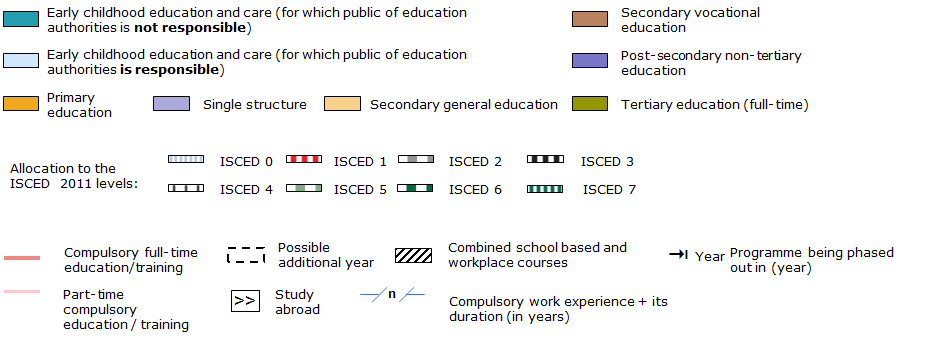Country Report
MONITOR TOOLBOX BY COUNTRY
France
1. Position in relation to strongest and weakest performers
2. Key Indicators
| France | EU | ||||||||
|---|---|---|---|---|---|---|---|---|---|
| 2012 | 2022 | 2012 | 2022 | ||||||
| EU-level targets | 2030 target | ||||||||
| Participation in early childhood education (from age 3 to starting age of compulsory primary education)1 | ≥ 96% | 100.0%13 | 100.0%21,p | 91.8%13 | 92.5%21 | ||||
| Low achieving eighth-graders in digital skills2 | < 15% | : | 43.5%18 | : | : | ||||
| Low achieving 15-year-olds in:3 | Reading | < 15% | 19.8%09 | 20.9%18 | 19.7%09 | 22.5%18 | |||
| Maths | < 15% | 22.5%09 | 21.3%18 | 22.7%09 | 22.9%18 | ||||
| Science | < 15% | 19.3%09 | 20.5%18 | 18.2%09 | 22.3%18 | ||||
| Early leavers from education and training (age 18-24)4 | < 9% | 11.8% | 7.6% | 12.6% | 9.6% | ||||
| Exposure of VET graduates to work-based learning5 | ≥ 60% (2025) | : | 70.5% | : | 60.1% | ||||
| Tertiary educational attainment (age 25-34)6 | ≥ 45% | 42.6% | 50.4% | 34.1% | 42.0% | ||||
| Participation of adults in learning (age 25-64)7 | ≥ 47% (2025) | : | : | : | : | ||||
| Other contextual indicators | |||||||||
| Equity indicator (percentage points)8 | : | 20.918 | : | 19.318 | |||||
| Early leavers from education and training (age 18-24)9 | Native | 11.0% | 7.2% | 11.3% | 8.3% | ||||
| EU-born | 25.1% | 11.1%u | 26.2% | 20.3% | |||||
| Non EU-born | 22.8% | 12.2% | 30.1% | 22.1% | |||||
| Upper secondary level attainment (age 20-24, ISCED 3-8)10 | 84.1% | 90.0% | 80.1% | 83.6% | |||||
| Tertiary educational attainment (age 25-34)11 | Native | 43.6% | 50.9% | 35.4% | 43.0% | ||||
| EU-born | 37.0% | 40.8% | 29.3% | 39.5% | |||||
| Non EU-born | 35.7% | 48.5% | 24.2% | 35.7% | |||||
| Share of school teachers (ISCED 1-3) who are 55 year olds or over12 | 14.7%15 | 16.9%21 | 23.4%15 | 24.5%21 | |||||
| Education investment13 | Public expenditure on education as a percentage of GDP | 5.5% | 5.2%21, p | 4.9% | 4.8%21 | ||||
| Public expenditure on education as a share of the total general government expenditure | 9.6% | 8.9%21, p | 9.8% | 9.4%21 | |||||
Sources: 1= Eurostat, [educ_uoe_enra21]; 2= IEA (ICILS 2018); 3 = OECD (PISA); 4= Eurostat, [edat_lfse_14]; 5 = Eurostat, [edat_lfs_9919]; 6 = Eurostat, [edat_lfse_03]; 7= not available; 8 = European Commission (Joint Research Centre) calculations based on OECD’s PISA 2018 data; 9 = Eurostat, [edat_lfse_02]; 10= Eurostat, [edat_lfse_03]; 11= Eurostat, [edat_lfs_9912]; 12 = Eurostat, [educ_uoe_perp01], 13= Eurostat, [gov_exp_10a]. Notes: the indicator used (ECE) refers to early-childhood education and care programmes which are considered by the International Standard Classification of Education (ISCED) to be ‘educational’ and therefore constitute the first level of education in education and training systems – ISCED level 0; the equity indicator shows the gap in the share of underachievement in reading, mathematics and science (combined) among 15-year-olds between the lowest and highest quarters of socio-economic status; b = break in time series, u = low reliability, : = not available, 09 = 2009, 13 = 2013, 15= 2015, 18 = 2018, 21 = 2021, p=provisional.
3. Annex I: Structure of the education system

Keys on the diagram 2023/2024

Source: European Commission/EACEA/Eurydice, 2023. The Structure of the European Education Systems 2023/2024: Schematic Diagrams. Eurydice Facts and Figures. Luxembourg: Publications Office of the European Union.
Note: ISCED 4 education covers less than 2 % of the total number of students (all levels). Young people aged between 16 and 18 can fulfil the obligation for compulsory training in different ways: schooling, apprenticeship, training courses, civic service, and support system or social and professional integration measures.
- Open data platform Education, Sports and Youth
- DEPP - Department of Evaluation, Foresight and Performance at the Ministry of Education
- Publication "L'Europe de l'Education en chiffres 2022" (DEPP)
- Publication "Etat de l'école 2022" (DEPP)
